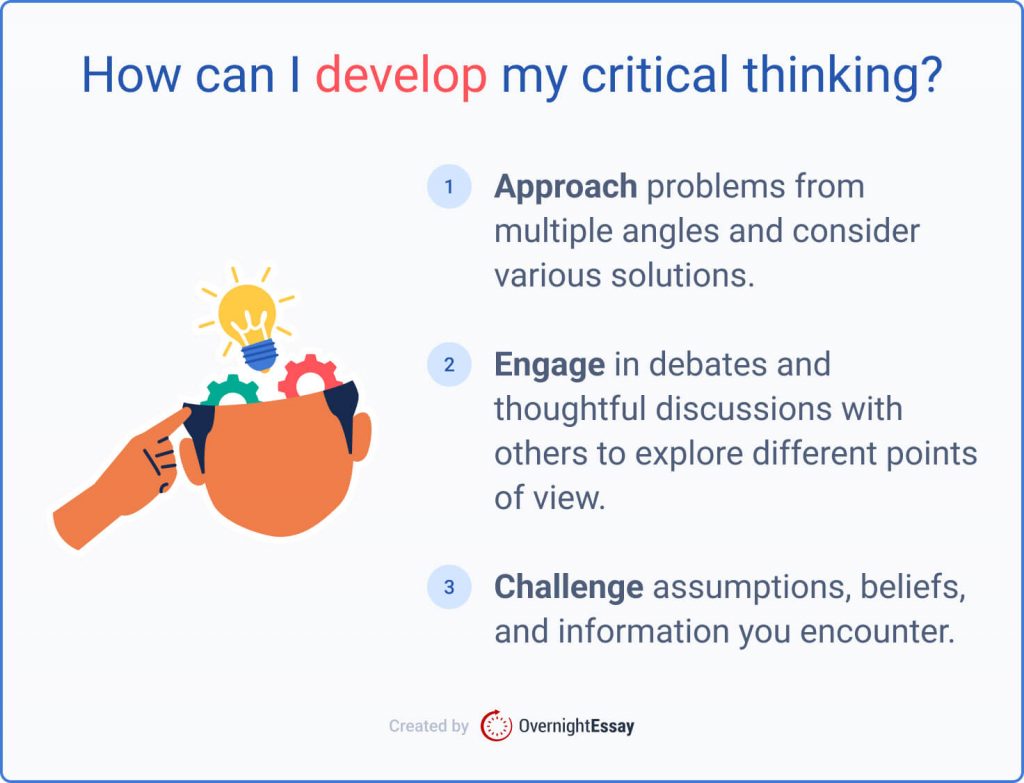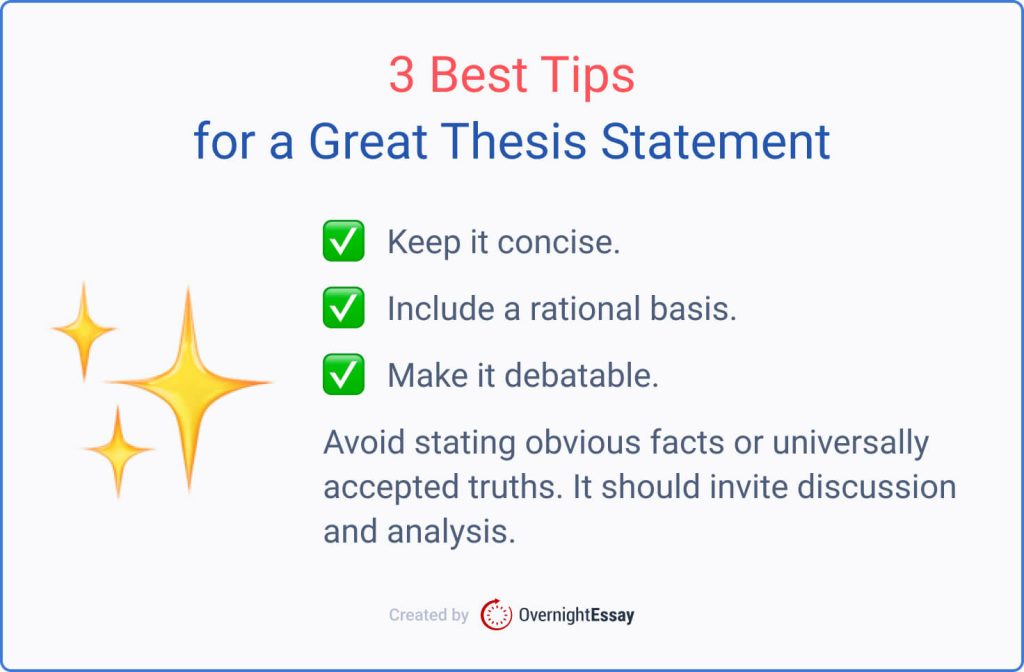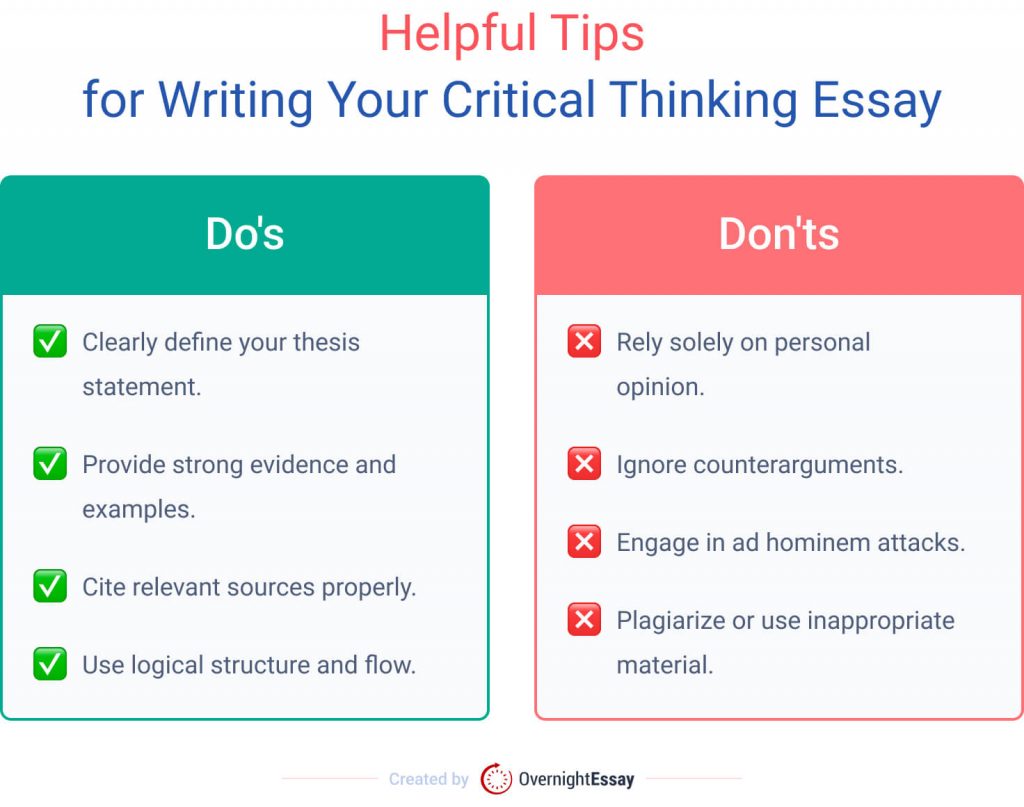Critical thinking is an essential skill everybody can master. It improves the quality of people’s academic, professional, and personal lives. This skill lets you analyze new information and view things from different perspectives. But what is it, and how do you develop it? What do you do if you have a critical thinking essay assignment?
Our experts will answer these questions and many more. Additionally, they will provide tips that will help you in the future and aid in writing your academic papers. You’ll read about the critical thinking paper format, browse various topics, and discover high-quality critical thinking essay examples.
🧠 What Is Critical Thinking?
Critical thinking lets you approach any issue logically and rationally. The references to this term go back to the Greek philosophers Socrates and Plato. It enables you to draw connections between ideas and events, interpret them, evaluate, and analyze information. In the end, you’ll find it easier to determine whether something is true or false. You also see the bigger picture and present your ideas more cohesively.

🧩 The Basics of Critical Thinking Essays
Working on your critical thinking will reap great rewards for your academic and daily life. Here are the changes and improvements you may notice for yourself:
What Is a Critical Thinking Essay?
A critical thinking essay has students analyze works from an author’s point of view. You can assess movies, poems, paintings, books, and other pieces of content in these papers. This academic paper lets students hone their analytical skills. The essay focuses a lot on how students interpret the meaning of the assessed work.
Unlike different types of essays and academic writing, this one doesn’t involve expressing personal subjective opinions. You can describe the subject of the study, detailing its core ideas and effectiveness. Your paper should make a coherent argument based on specific examples.
The Critical Thinking Process
As you can see, critical thinking skills are vital to your academic, professional, and personal growth. They come in handy not only in the college environment but also in improving the quality of your daily life.
The internet and social media are filled with misinformation and fabrications. Critical thinking makes it easier to navigate this sea of half-truths. Several steps can help you develop this skill.
- Find the problem. Identify the issue you’re trying to solve. Ask what happened, why, what assumptions you’ve made, and how it can be solved at first glance. Clearing these details makes it easier to pursue the next steps.
- Do your research. Once you establish what’s wrong, identify its causes. Find out why it happened, who is responsible, and what the outcome can be. Use as many sources as you can to see the whole picture.
- Establish data’s relevance. After you’ve gathered enough facts, check the credibility of the sources. Look only for information that’s relevant to your issue. It will help you reach the best conclusion.
- Ask questions. Your decision should be unbiased. It can be achieved by questioning your assumptions, possible variables, various perspectives, and points of view you might have ignored. These aspects make your thought process more logical and less personal.
- Search for the best solution. To achieve this, connect the causes and effects of the problem. Find the best way to address it by assessing the gathered facts. Often, this process isn’t as straightforward, as there are too many factors to consider.
- Present it. Next, present your solution to the interested parties. Sometimes, you have several equally good solutions to propose. Keep testing them one by one until you find the right match.
- Assess your choice. Finally, inspect how well your solution worked. It may be a huge success but is equally likely to fail wholly or partially. You can still learn valuable things from this experience.
12 Essential Critical Thinking Questions
We would also like to cover 12 helpful tips for assessing all types of information. Practice them, and you’ll soon be able to improve your critical thinking skills.

- How did you learn this?
- How would you approach this issue?
- Do you agree or disagree with the author?
- Would you change your mind when faced with new facts?
- Are there more than two sides to this problem?
- Did you do thorough research?
- What would be an ideal outcome?
- What is the other side of this argument?
- How can you stop this problem from occurring?
- Why is this an issue in the first place?
- Whom can this problem affect the most?
- How can you tell if something works or not?
⚠️️ Fallacies in Critical Thinking
Learning about the definition and process of critical thinking is only the first step. You should master how to identify common fallacies to continue developing this skill. These are mistakes in reasoning that can lead to the wrong conclusions even with the correct facts.
Logical fallacies occur when there’s a gap in your logic or you’re deliberately trying to mislead people. Essentially, they go against some of the principles of reasoning. There are several types of fallacies you can encounter when conducting critical analysis.

📑 Critical Thinking Essay Structure
You can write a critical thinking essay by yourself when you are familiar with the writing process and logical fallacies. We’ve prepared this segment to make your work as effective as possible. Here, we will go through the stages of a standard critical thinking essay and what to include in each of them. Besides, after reading it, you won’t have issues writing thesis statements.
How to Start a Critical Thinking Essay?
Like all essays, papers on critical thinking begin with an introduction. Here, you provide basic information about your subject, its origin, and its significance. Always start with a hook sentence that contains a fact, a quote, a statistic, or an interesting question. It’s your way of teasing what the critical thinking paper is about.
Introduction: Background and Thesis
The introductory part of your critical thinking paper tells readers what it will be about. Here, you also explain the subject of your paper and why it’s crucial. Provide exciting background data so that people understand the topic. End with a thesis statement that introduces the rest of your writing. Here are some tips to make it perfect:
- Don’t go into much detail. A good introduction should disclose the right amount of information that makes people read more. Ideally, an intro looks like a teaser for a movie you’re about to see.
- Explain the topic in plain terms. Write the introduction from the perspective of someone who knows nothing about the paper’s main subject. You can never assume that everybody is on the same page as you.
- Stay brief. Don’t get carried away; trim this part until it’s about 250 words long. Edit and rewrite until you get a snippet of the paper in a couple of paragraphs.

Body Paragraphs
After you finish the previous part, it’s time to present your arguments in the body. This section can be divided into several segments. The first paragraph summarizes the work or a concept you’re assessing without personal opinions. The second one contains your evaluation, including the strong and weak points.
There are several things to consider when writing this part of the critical thinking paper:
- Look for controversies and biases. A good critical essay should uncover biases and controversial statements made by an author. Point them out even if you enjoy the work, as this is a matter of fact.
- Establish inconsistencies and fallacies. Nobody can be 100% logical all the time. To make your paper more solid, look for errors or inconsistent arguments.
- Find points of connection. Finally, look for things you agree with about the author. This way, you’ll add authenticity to your work and make it stand out among other submitted papers.
Conclusion
The conclusive part of the essay reinforces the content of the introduction and body paragraphs. It tells readers what makes the subject of your paper unique and worth discussing. Here, you summarize the strong and weak points of the topic. Tell your audience about the personal effect it had or how it inspired you.
There are several things you can do to write a better conclusion:
- Reread the entire paper. This way, you can reflect on the text and include the right focal points in the final part. Do this several times until you find the right words for the conclusion.
- Share your thoughts. The final part should contain your general opinion about the assessed subject. You can agree or disagree with its author and provide several ways to improve or change things.
- Reinforce the significance of the evaluated work. Recognize why the person’s work influences a particular field and how it can be used in further studies.
How to Write a Critical Thinking Essay: Key Takeaways
To start a critical essay, you need a solid central argument. Once you have one, collect information from reliable sources. Next, you develop a thesis statement and draft an outline. Then, you will have everything necessary to start writing your assignment’s introduction, body paragraphs, and conclusion.
💡 Critical Thinking Paper Topics
If you still struggle with finding the right theme for your work, don’t worry. We’d like to introduce a list of critical essay topics and questions. It’s bound to have exciting and inspirational ideas that can serve as inspiration or the subject of your academic papers.
- What are the benefits of social work for lawbreakers?
- Is psychology a real discipline, or is it made up?
- Theme of loss in Islands in the Stream.
- Show how the movie The Night in Lisbon depicts immigration.
- A reflection on the fall of Troy.
- What can people learn from stoic philosophy?
- Leading causes of eating disorders.
- The role of racism in university admissions.
- Can peer pressure be beneficial?
- Discuss the main ideas of The Pickwick Papers.
- Can we stop global warming?
- Is there a formula for an Oscar-winning movie?
- An examination of ethnic and gender stereotypes in British songs.
- The leading causes of Roman decline.
- Was America founded on the wrong ideas?
- Analyze the portrayal of Asian Americans in modern movies.
- What are the main factors of developing a pack mentality?
- The influence of teachers on children’s education.
- What are the main pitfalls of sex education in US schools?
- Does art therapy help alleviate symptoms of PTSD?
- Is comedy a dying art?
- Analyze the history of Imperial Japan.
- Primary factors that lead to alcoholism.
- How is womanhood depicted in Anna Karenina?
- Why are people obsessed with The Sopranos?
- Ways to clean plastic from the ocean.
- Evaluate the portrayal of Atticus Finch by Gregory Peck.
- Why do people fail to learn from historical mistakes?
- The effect of abusive relationships on children.
- Analyze the influence of book titles on reader expectations.
- Why are people fascinated by dangerous animals?
- How do problem-solving skills help with team management?
- What are the ethical implications of animal testing?
- Should everybody get a college education?
- The main outcomes of WW1.
- Was the USSR set up for failure?
- Describe how justice is portrayed in Les Miserables.
- Evaluate the efficiency of green technology.
- Why do some people have trouble with decision-making?
🌟 Critical Thinking Writing Examples
Finally, we would like to show several critical thinking essay examples. Reading them will give you a better understanding of how to begin writing your work and which direction to choose.
- Critical Thinking in Educational Psychology
Teaching students about making rational decisions is one of the main goals of education. It’s vital to foster critical thinking, which is a handy skill to have in modern society. Nowadays, these efforts are justified by the need to navigate vast data streams and make thoughtful decisions about their reliability. However, certain controversies are involved in its theoretical and practical use, especially about how schools teach people about critical thinking and the result of their efforts. This paper aims to assess the framework of issues related to critical thinking and ways of improving its teaching in educational psychology.

- Mass Media: Critical Thinking Skills, Images, and Stereotypes
Being able to think critically lets you question your beliefs and any new information. It makes your thinking clear and rational, allowing you to see logical connections between facts and use them to form solid arguments. Reason lets you master this process through active research instead of passive observation. It’s crucial in the modern world and its oversaturation with information. The rise of fake news makes it worthwhile to avoid provocations and see events for what they are. You’ll need analysis, creative thinking, interpretation, judgment, problem-solving, and reasoning to make better decisions. - Critical Thinking in Nursing Care
Critical thinking is one of the essential skills when it comes to patient care. It lets you come to the right conclusions through the use of such tools as analysis, consideration, interpretation, evidence, and methodology. Major theories and components are crucial for making effective decisions. One of them is the ability of nurses to understand and solve issues through rationalization. All while following established rules and guidelines. They improve their results and create a safer work environment.
We wish you the best of luck writing your superb critical thinking papers. Be sure to practice our tips and try our handy thesis statement generator! Also, feel free to share our guide with friends.